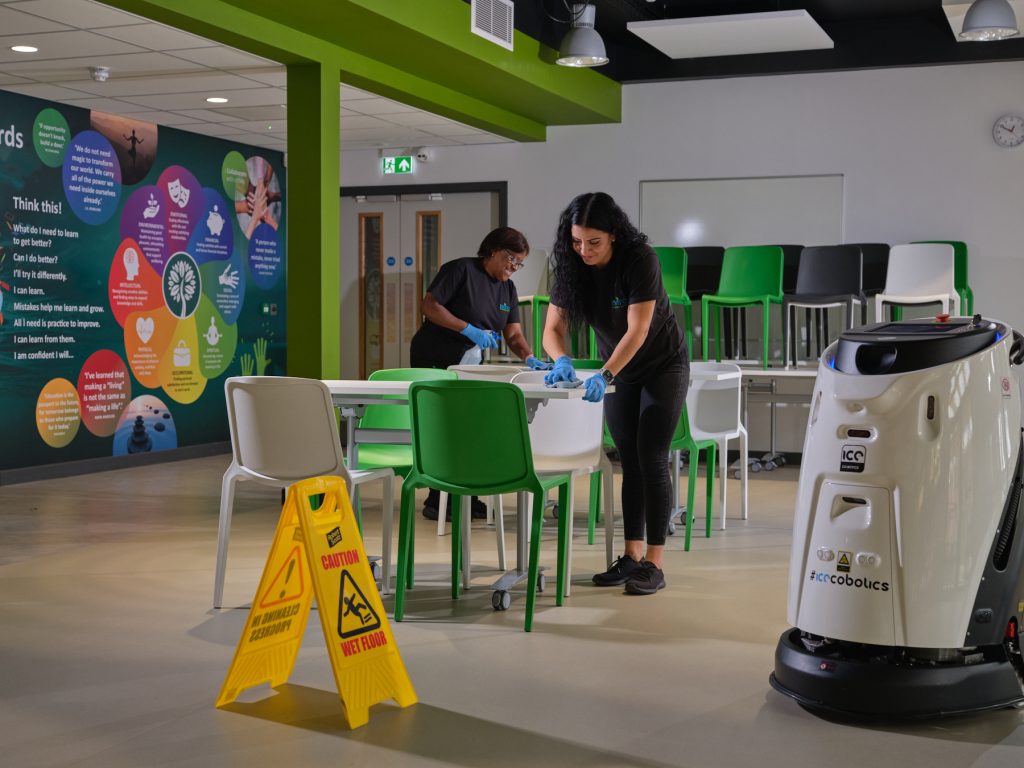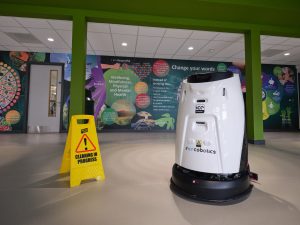How cobotics give cleaning teams a boost in your school
01 November 2022 Category: Educational Establishments Schools, Academies and Trusts
Innovation is at the heart of cleaning. Long gone are the days where a domestic cleaning service would turn up to a site armed with lemon juice and a toothbrush. Technology progresses, and it is our job to progress with it – because any new opportunity to create cleaner, more hygienic and safer learning environments will lead to better learning outcomes.
Want to keep up with that evolution? Then the first step is to be aware of the major movements that will, now or eventually, change how cleaning services interact with your school. Let’s take a look at cobotics.
Cobots or robots?
In earlier days, people had different ideas about the future of tech in the cleaning industry. Robots were pitched as a replacement to labour, but there were problems: they were slightly unwieldy, the interface was difficult, and user engagement was poor. And if that’s the image you have of this tech now, we have good news: it’s changed.
For a start, the labour market has changed and cleaners are a very precious resource. All companies are now needing to pay more to get good quality cleaners. So tech is now becoming a solution for when a company can’t get enough cleaners to service a contract. That tech can also allow cleaning companies like Nviro to pay people more.
Rather than looking at what couldn’t be done with the technology, there is now a sense of what could be done. Instead of being fully autonomous and self-directed, cobots were developed to work cooperatively with our cleaners. They don’t replace our people, they work alongside them.
The types of cobots – and the ones you need
When people think of cobots, they may still think of former unwieldy machines, but things are a little different now. There are two main types of cobots: the big ones, and the little ones.
- The big ones.
If you can picture an industrial-sized push-along scrubbing machine, you can picture this. They’re the same, but not manned. The large cobots are designed for deep cleaning. They have the functionality to operate across carpeted rooms, but also hard floor rooms, so sports halls, canteens, and drama studios are no issue for these nifty bots.
- The little ones.
The small cobots have a similar exterior to the disc-shaped robot vacuums that are all the rage at the moment, but they pack a different punch.
The common, smaller commercial products are similar to those designed for domestic use. They’re the ones that roam around a room, vacuum, bump into furniture, redirect, and eventually clean most of a room. However, the smaller cobots have innovative line-tracking technology. They’ll have a scanned outline of the room, vacuum more efficiently than an in-home product, and fill in the gaps that domestic bots might miss.
How cobots create better learning environments
This shift is important for staying at the cutting edge of industrial cleaning services. Cobotics doesn’t exist so that cleaners no longer have to use manual equipment, but it does mean that cleaners can set a cobot down to do its job while they do something else. We like to use the dishwasher analogy: you don’t buy a dishwasher because it’s faster than washing by hand. You buy one so you can focus on other things while the washer is doing the dishes.
This means our cleaning teams are able to make things cleaner quicker, but there are other tangible benefits to cobots. The larger ones are able to send reports and data analysis on their cleaning task. ATP testing has shown that areas cleaned with our cobots have less bacteria levels in them, and cobots use less power than their counterparts to do this too.
Cobots are also more efficient at covering space: they’re designed not to miss anything that might be overlooked due to human error, and they’re great at reaching difficult-to-access areas, like the awkward corners around the music department’s piano.
How do we use cobots in schools?
At Nviro, we first investigated robotics as part of our business about four years ago, but it’s been in the past two years in particular that we’ve been able to seriously consider the use of cobots.
The smaller cobots units tend to be sold in towers of 6 – 10, depending on the manufacturer. These will be handled by a cleaning colleague, who will enter a facility, wipe the surfaces and do a floor check for any wires or loose items that a cobot needs to avoid (a job we are able to do effectively in schools thanks to so many cooperating in (housekeeping). After this, they can set the cobot down and get to work.
We have 12 of the latest type in the Winston Churchill School in Woking, and 20 at a site in Brighton. We also have a large cobot which is soon to start work at Merstham Park, a fully environmental, sustainably built school in Redhill. And we’re seeing great results across the board.
Our promise to you
We’re not going to tell you to take on cobots if they can’t improve your learning environment or budget. The larger cobots are a larger financial investment, but they can create financial savings in the long run.
The reason cobotics are on the cutting edge of the cleaning world is because they are incredibly good at what they do, and they’re getting better. Some people may feel uncomfortable about pricey tech working alongside cleaners in schools, and to that we say: all the more reason to get involved.
At Nviro we have been able to look at elements of cobots that once needed improvement, and over our time of interacting with them, we’ve been able to shape the way they’ve been utilised based on feedback to the manufacturers. We’re already shaping the way cobots can be improved for the next generation of machines on the market.
What seems more appealing to you? Adapting to a new technology early, figuring out what’s great about it and what could be better, and suggesting improvements based on a wealth of experience? Or waiting until every cleaning company everywhere is using them, and hoping the way they work will be suited to your school’s needs?
Cobots might not be the best option for your school’s specific needs, but they are definitely worth considering. If you’d like to learn more or explore how cobots could make a difference to your learning environments, don’t hesitate to get in touch.
As a specialist cleaner in educational settings, Nviro provides clean, hygienic and safe environments in universities, colleges and schools. Read our blog about the benefits of outsourcing cleaning and how this can help your staff.
Cobotics can provide an effective and innovative cleaning solution for most organisations, but there are several factors that you should consider before investing in one. Check out our Frequently Asked Questions (FAQ) below to help you decide if they are right for your environment.


